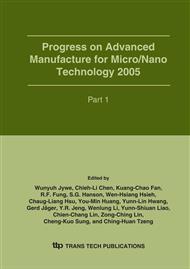p.1123
p.1129
p.1135
p.1141
p.1147
p.1153
p.1159
p.1165
p.1171
A Hierarchical Self-Organizing Neural Network for Automatic Wafer Defect Inspection
Abstract:
The wafer defect inspection is an important process before die packaging. The defective regions were usually identified through visual judgment with the aid of a scanning electron microscope. Dozens of people visually check dies and mark their regions manually. Thus, potential misjudgment may be introduced due to human fatigue. In addition, the process can incur significant personnel costs. Self-Organizing Neural Networks (SONNs) have been proven to have the capabilities of unsupervised auto-clustering. In this paper, a hierarchical self-organizing neural networks (HSONN) with consideration of multiple textural information is proposed to replace the traditional electrical testing and the human inspection processes. The proposed HSONN is consists of 3 layers, each layer is a specific cluster to separate the block of wafer image into normal and defective regions. The suspicious defective regions are used as inputs to the next layer of HSONN for subsequent classification of the defective regions. Through the hierarchical classify, the output of the 3th layer denotes the detecting defective regions. Based on real-world data, the experimental results show that the proposed method successfully identifies the defective regions on wafers with good performances.
Info:
Periodical:
Pages:
1147-1152
Citation:
Online since:
January 2006
Authors:
Price:
Сopyright:
© 2006 Trans Tech Publications Ltd. All Rights Reserved
Share:
Citation:


